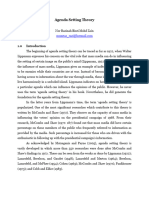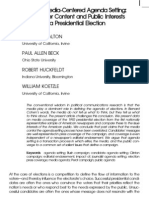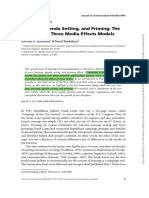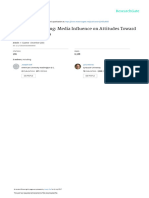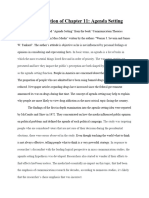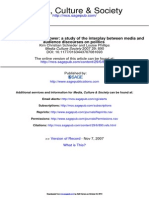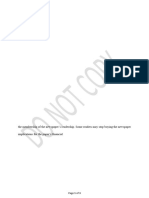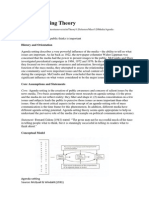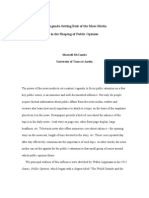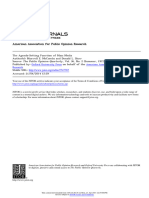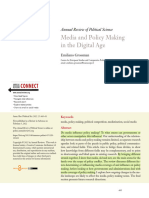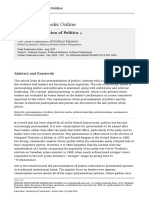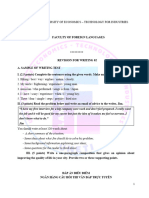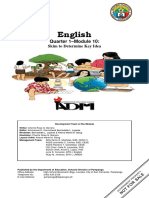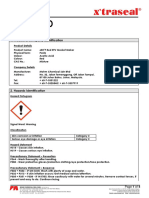Front-Page News and Real-World Cues A New Look at Agenda-Setting by The Media
Front-Page News and Real-World Cues A New Look at Agenda-Setting by The Media
Uploaded by
Nikolina PeršićCopyright:
Available Formats
Front-Page News and Real-World Cues A New Look at Agenda-Setting by The Media
Front-Page News and Real-World Cues A New Look at Agenda-Setting by The Media
Uploaded by
Nikolina PeršićOriginal Title
Copyright
Available Formats
Share this document
Did you find this document useful?
Is this content inappropriate?
Copyright:
Available Formats
Front-Page News and Real-World Cues A New Look at Agenda-Setting by The Media
Front-Page News and Real-World Cues A New Look at Agenda-Setting by The Media
Uploaded by
Nikolina PeršićCopyright:
Available Formats
Front-Page News and Real-World Cues: A New Look at Agenda-Setting by the Media
Author(s): Lutz Erbring, Edie N. Goldenberg and Arthur H. Miller
Source: American Journal of Political Science, Vol. 24, No. 1 (Feb., 1980), pp. 16-49
Published by: Midwest Political Science Association
Stable URL: http://www.jstor.org/stable/2110923 .
Accessed: 19/07/2014 05:27
Your use of the JSTOR archive indicates your acceptance of the Terms & Conditions of Use, available at .
http://www.jstor.org/page/info/about/policies/terms.jsp
.
JSTOR is a not-for-profit service that helps scholars, researchers, and students discover, use, and build upon a wide range of
content in a trusted digital archive. We use information technology and tools to increase productivity and facilitate new forms
of scholarship. For more information about JSTOR, please contact support@jstor.org.
Midwest Political Science Association is collaborating with JSTOR to digitize, preserve and extend access to
American Journal of Political Science.
http://www.jstor.org
This content downloaded from 129.130.252.222 on Sat, 19 Jul 2014 05:27:57 AM
All use subject to JSTOR Terms and Conditions
Front-Page
NewsandReal-World Cues:
A NewLook at Agenda-Setting
bytheMedia
Lutz Erbring,University
of Chicago
Edie N. Goldenberg,ArthurH. Miller,University
ofMichigan
Researchon the agenda-setting role of the newsmediahas oftenbeen guidedby
a rathernarrowconceptionof how media contentaffectsmembersof the public.In
particular,relianceon a "mirror-image" modelof media effects, and a focuson "the
agenda"as an overallrankingof issues,has notshedmuchlighton theprocesseslink-
ing publicissue salienceto varyingmedia attention.This studyintroducesan "audi-
ence-effects"modelwhichtreatsissue-specific audiencesensitivities
as modulators,
and
newscoverageas a trigger stimulus,
of media impacton issuesalience,issueby issue.
An analysisof "most importantnationalproblem"mentionsin the 1974 National
ElectionStudy,augmentedby data on front-page contentin the newspapersread by
respondents and on "real-world"conditionsin the respondents'commuLnities,provides
considerableempiricalsupportfor the proposedaudience-contingent effectsmodel.
In addition,secondarydiffusion of problemsalience throughnetworksof informal
social communication is shownto eventuallyoverrideearlynewsmediaimpact.Our
findings underscorethe need forresearchon agenda-setting to focuson boththetem-
poraland thesocial dimensionof mediaimpact.
Introduction
Research on the politicalinfluenceof the news media has tradition-
ally employedparadigmswhich describe attitudechange in response to
"persuasive communication"(Klapper, 1960; Pool et al., 1973; also
Kraus and Davis, 1976). The traditionalpreoccupationwiththe public's
attitudestowards issues and with its policy preferences,however, has
graduallybeen temperedby the realizationthat politicalissues must be-
come salientbeforetheycan be the object of attitudes,whetherfavorable
or unfavorable.1"Agenda-setting"refersto the process by which prob-
1 We followthe usual distinction betweenattitudes(characterizedby evaluative
directionand affectivepolarity) and cognitions(characterizedby perceptualdif-
ferentiation and affectiveneutrality).By thisdefinition,
supportfor the presidentor
oppositionto busingare politicalattitudes,while acknowledgment of government
corruption or concernover race relationsare politicalcognitions.
Usingthe same distinction, some authorshave recentlyurgedmedia researchers
to focusattentionon the effectsof the media on cognitiveratherthan attitudinal
states;see, e.g., Becker,McCombs,and McLeod (1975). We have arguedelsewhere
AmnericaniJournal of Political Science, Vol. 24, No. 1, February 1980
?) 1980 by the University of Texas Press 0092-5853/80/010016--34$02.65
This content downloaded from 129.130.252.222 on Sat, 19 Jul 2014 05:27:57 AM
All use subject to JSTOR Terms and Conditions
AGENDA-SETTING BY THE MEDIA 17
lems become salient as political issues around which policy alternatives
can be definedand supportor oppositioncan be crystallized(Cobb and
Elder, 1972; Bachrach and Baratz, 1970). In this context,agenda status
refersto issue salience (relativeperceivedimportanceof a problem), not
issue position(relativeapprovalof a policy).
"Politicalagenda" is merelyshorthandfora community's issue prior-
ities. It could however,mean severaldifferent things,dependingon one's
definitionof "community.""Political agenda" mightreferto the issues
consideredfor policy action by some governmentalbody (Cobb and
agenda); or to the issues espoused by variousleader-
Elder's institutional
ship segments,includingpolitical leaders, interestgroup leaders, and
the media (Walker, 1977); or to those issues which reflectthe concerns
of a large proportionof the generalpublic. These aspects of a commun-
ity'spoliticalagenda are hardly,of course,independentof each other;on
the contrary,the relationshipsamong them are of major theoreticaland
empiricalinterest,since togethertheydrivethe processof politicalagenda
building.
Followingpreviousresearchon agenda-setting, our studywill define
the politicalagenda as the concernsof the generalpublic. We will focus
on one componentof the agenda-buildingprocess-the role of the mass
media in determining the scope and depthof public concernover partic-
ular issues. As Walter Lippman points out, the media are importantin
shapingour notionof the worldbeyondwhatwe can experiencedirectly-
and the worldof politicsis almostentirelybeyondthe reachof our direct
experience.
Previous agenda-settingstudies appear to have adopted a simple
"mirror-image"hypothesisabout media effects.2That is, researchon the
thatthe traditionalconcernwith the media's effectson politicalattitudes-effects
whichneed not involveany consciouspersuasiveintent-may,however,have been
abandonedprematurely; cf. Miller,Goldenberg,and Erbring(1979).
2 Most agenda-settingstudiesto date have focusednarrowlyon electioncam-
paigns.Studiesbased on a singlecommunity at a singlepointin time include: Mc-
Combsand Shaw (1972), who foundthatissuesemphasizedby the media in Chapel
Hill, NorthCarolina duringthe 1968 presidential campaignwerethe same as those
consideredimportant by a sampleof votersinterviewed duringthe same period;Mc-
Leod, Becker,and Byrnes(1974), who foundpartialsimilarities in issue emphasis
betweenregistered votersin Madison,Wisconsin,and thelocal newspapersthesevot-
ers read duringthe 1972 electioncampaign;and Bentonand Frazier (1976), who
found,in Minneapolis,Minnesota,thatsimilarissueswere emphasizedin the news-
papers(but not television)and in the surveyresponsesof Minneapolisresidents.
Examplesof studiesbased on two or moretimepointsare: Tipton,Haney,and
This content downloaded from 129.130.252.222 on Sat, 19 Jul 2014 05:27:57 AM
All use subject to JSTOR Terms and Conditions
18 Lutz Erbring,Edie N. Goldenberg,ArthurH. Miller
subject has generallytriedto establishsome overall match betweenthe
relativefrequencyof the news media's coverageof a set of issues,on the
one hand, and the relativesalience of the same set of issues among the
audienceor thegeneralpublic,on theother(McLeod, Becker,and Byrnes,
1974; McCombs and Stone, 1976; Shaw and McCombs, 1977). And
even scholarswho emphasizethe importanceof specificaudience charac-
teristics(e.g., "need fororientation,"uncertainty
about vote choice, etc.)
have continuedto pursue the same approach,focusingon the degree of
correspondencebetweenthe issue agenda of the news media and that of
particularaudience segments(McCombs and Weaver, 1973; McCombs,
Shaw, and Shaw, 1972).
But thisfocuson the agenda as an overall patternor gestaltignores
the obvious factthatissue concernscan and do arise fromsources other
than media exposure-notably frompersonalexperiences,group perspec-
tives,and real-worldconditions-and thatthesefactorswill varynot only
across individuals,but also amongissues and over time.Differential
media
treatment is but one factoramongmanythatdeterminethe salience of is-
sues. To comparethe distribution of media coverageand audiencesalience
across issues is, therefore,pointless.Widely differingdistributionsmay
Baseheart(1975), who applied cross-laggedcorrelationsto surveyand newspaper
data collectedduringthe 1971 Kentuckystateand local electionperiod,and found
inconsistent resultswithrespectto causal priority;McCombs,Shaw, and colleagues
(Shaw and McCombs, 1977; Weaver,McCombs and Spellman,1975), whose cross-
laggedpanel correlations and cross-time
comparisonsyieldedmixedresultsfornews-
paperand televisionimpacton agendacompositionand respondent in Char-
priorities
lotte,NorthCarolina,duringthe 1972 presidentialcampaign;Siuneand Borre(1975),
who examinedpanel data collectedbeforeand afterthe 1971 Danish generalelection
and concludedthatmass media outputplayeda limitedrole in alteringthe public's
issuepriorities;and Pattersonand McClure (1976), who,on the basis of panel sur-
veysin Syracuse,New York, and of contentanalysesof politicalnews and commer-
cials on televisionduringthe 1972 presidential
campaign,arguedthatthe effectsof
network agenda-settingweresuperficial.
A ratherdifferent,issue-based,approachis represented by Funkhouser(1973),
who comparedtime series for media treatment of specificissues (in threeweekly
news magazines) with surveyinformation on "the most importantproblemfacing
America' and withmeasuresof objectivecircumstances over time.He foundthatthe
relationship betweenmedia emphasisand real-worldcircumstances was tenuous,and
concludedthatthe media,ratherthanthereal world,set the public'sagenda.Funk-
houser'saggregatedata, however,do not permitspecificmedia-audiencelinkage.
Zucker(1978) similarly examinedtheimpactovertimeof televisionnewscoverageof
specificissuesand foundeffects contingenton messageproperties such as "obtrusive-
ness"and "duration."
This content downloaded from 129.130.252.222 on Sat, 19 Jul 2014 05:27:57 AM
All use subject to JSTOR Terms and Conditions
AGENDA-SETTING BY THE MEDIA 19
conceal substantialmedia impact (since audience salience will also reflect
issue-specificfactorsotherthan media coverage), while closely matching
distributions may convey a spurious impressionof media impact (since
both media and audience may respondindependently to the same exogen-
ous factors). In short,the attemptto deal with agenda-setting effectsby
treatingthe political agenda as an integralconstructat the operational
(ratherthan the theoretical)level invalidatesthe analysisfromthe start.
Clearly,it is necessaryto proceedissue by issue when examiningthe
effectsof the media's agenda-setting. Even then, a simple mirror-image
model is insufficient to assess media effects.Differential media treatment is
again but one of many possible causes of differential issue salience. The
absence of a correlationbetweenmedia coverage and issue salience may
conceal actual media impactif thatimpactis offsetby prioraudience dif-
ferences(e.g., readershipself-selectionbetween two newspapersin the
same community),while the appearanceof a correlationmay be spurious
if it merelyreflectsparallel audience and/or context differences(e.g.,
shared newspaperand audience concernsin each of two differing com-
munities).In short,even at an issue-specific level the attemptto deal with
the effectsof agenda-setting by the news media in isolation fromother
possible determinantsof issue salience is likely to confound empirical
analysis.
Beforeone can identify and interpretthe effectsof agenda-setting by
the news media, therefore, it is necessaryto specifyan explicitmodel of
issue salience. Even if the effectsof media coverageare the primaryana-
lyticand substantiveinterest, the model should include,foreach particular
issue, individual/collective audience characteristics and/or real-worldcon-
ditionslikely to affect issue salience. Moreover, as some of the relevant
variableswill differnot only betweenissues but also across individuals,
the model mustbe specifiedat the microlevel,i.e., at the level of the in-
dividualrespondent.
However,even an issue-specific micromodelmay not representade-
quatelythe processof agenda-setting by the news media if it assumesthat
the amount of coverage given an issue affectseveryonein the audience
equally. Two membersof an audience may well react differently to the
level of issue coveragein a given news source, dependingon theirindiv-
idual predispositionstoward the particularissue. Consequently,estimates
of media impactmay become dilutedbeyondall usefulnessif theymerely
representaverage effectsacross a heterogeneousaudience, only some of
whose membersare sensitiveto the particularissue in question.Not only
do the audience's issue-specific influenceissue salience in
characteristics
This content downloaded from 129.130.252.222 on Sat, 19 Jul 2014 05:27:57 AM
All use subject to JSTOR Terms and Conditions
20 Lutz Erbring,Edie N. Goldenberg,ArthurH. Miller
theirown right,but they also sensitize or desensitizethe individualto
media coverage of a particularissue. In short,we must ultimatelyap-
proach agenda-setting by the news media in termsof audience-contingent
media effectsembeddedin an issue-specific micromodelof salience. It is
the object of this paper to do so.
One finalpoint may be in order.It should be clear that,at least as
far as the salience of nationalissues and the compositionof the national
political agenda are concerned,cross-sectional(i.e., local or individual)
variationin media coverageand salience perceptionsessentiallyrepresents
idiosyncraticor nuisance variance,i.e., "noise." The process of agenda-
settingobviouslytakes place over time,not across regions,states, local-
ities,or individuals,even if some cross-sectionalvariationmay reflectsys-
tematicdifferences, not merelyrandomfluctuations. This has two rather
importantimplicationsfor the purposes of this study. In the firstplace,
a cross-sectional designcannot hope to capturemuchvariationin national
agenda-setting; at best,it can captureenoughsystematic varianceto afford
a glimpse at the processes underlyingagenda-settingand to assess the
validityof a particularmodel. In the second place, using a cross-sectional
design makes it all the more essential to include controlsfor alternate
sources of issue salience whichare likelyto exhibitcross-sectionalvaria-
tion. By contrast,the self-anchoring propertiesof a longitudinaldesign
would automatically control for such individualand/or local sources of
variation.Nonetheless,whiletherecan be littledoubtthata cross-sectional
designis the least appropriatefor the studyof agenda-setting effects,we
mustmake do withthe data at hand and leave the prospectof more suit-
able designsforfuturedata collectionefforts.
Our analyses are based on data fromthe 1974 National Election
Studyconductedby the Center for Political Studies at the Universityof
Michigan. That studyincludedan extensiveseries of questionsdesigned
specificallyto tap both newspaperand televisionusage habits,along with
the usual complementof politicalattitudequestions.The dependentvaria-
ble, issue salience,is measuredby the familiaropen-endedquestionabout
the"mostimportant problem(s) facingthiscountry,"coded as a binaryre-
sponse (mention/nomention) for each issue. The CPS surveydata were
supplementedfor our analyses by two additionaldata sets. First, media
contentdata were gatheredfromthe daily newspaperspublished in the
1974 surveysites for ten days of the threeweeks that preceded the in-
terviewingperiod.3For those 94 newspapersactually read by seven or
:1Newspaperswere collectedfromOctober 16, 17, 24, 25, 27, 29, and 30, and
This content downloaded from 129.130.252.222 on Sat, 19 Jul 2014 05:27:57 AM
All use subject to JSTOR Terms and Conditions
AGENDA-SETTING BY THE MEDIA 21
moreof the 1974 surveyrespondents, all front-page
articles(about 8,900)
were manuallycoded for issue contentand mergedwith the surveydata
by matchingeach respondentwithcontentinformation fromthe particular
paper he or she had read.4Secondly,contextualdata on local unemploy-
mentand crimeratesin 1972 and 1974 were also gatheredforthe survey
sitesand mergedwiththe surveyand media data at the level of the indiv-
idual respondents.5Linkingthese sets of data allowed the joint analysis
of survey,media content,and contextualvariables that our substantive
hypothesesrequired.
While our data share the design problemsof earlier cross-sectional
studies,theyalso allow us to compensatefor these potentialweaknesses
in several importantways. Our data: (1) are national in scope, in order
to ensuremaximumvariancewithinthe limitsof a cross-sectionaldesign;
(2) includemeasuresof actual media content,in orderto avoid imputing
effectsto the mere fact of media exposure; (3) include real-worldmeas-
ures forsome key issues,in orderto controlfor relevantlocal conditions;
and (4) link media content,real-worldconditions,and salience percep-
tionsat the individuallevel,in orderto circumventthe pitfallsof aggregat-
ing across heterogeneous populations.
Given these unique opportunities,we hope to bring into view the
processesand conditions,ratherthan merelythe existence,of agenda-set-
tingeffects.We shall begin witha briefexaminationof our data in terms
of mirror-image assumptionsand thenturnto the audience-contingent ef-
fects model we offeras a more complete and accurate specificationof
media effectsin the agenda-setting process.
Agenda-Settingby the Media: Mirror-ImageEffects
of front-pagenews-
The graph in Figure I shows the distributions
fromNovember1, 3, and 4. The three-week spreadof samplingdaysdoes not permit
any longitudinal"trace"of media content;it merelyprovidesa statisticallyreliable
sampleof mediacontentat a singlepointin time.
4 The originalsample of newspapersnumbered170; the 94 papers that were
content-coded accountedfor 85 percentof all newspaperreadersin thesurvey.
5 The crimestatistics
for both property and violentcrimeswere gatheredfrom
U.S. Federal Bureauof Investigation(1972, 1974).
The unemployment figureswere collectedby the Institutefor Social Research.
University of Michigan.undercontractwiththe Officeof the AssistantSecretaryfor
Planningand Evaluation,U.S. Departmentof Health,Educationand Welfare.The
originaldata had been obtainedwithquestionnaires mailedto countyofficesrespon-
sible for maintaining
unemployment records,as partof "A Panel Studyof Income
Dynamics,"underthe directionof Dr. JamesN. Morgan.
This content downloaded from 129.130.252.222 on Sat, 19 Jul 2014 05:27:57 AM
All use subject to JSTOR Terms and Conditions
22
FIGURE 1
DISTRIBUTIONS OF ISSUE COVERRGERNO ISSUE MENTIONS
37.5 _ 75.0
NEWSPRPERS
PUBLIC
251 0--50.00
0 ~~~~~~~~~~~z
012.
ma AA SE0 25. 0 ic
z
0.*06YTUTN
GVYTRUST NFLRTION
--L
CRINE SHORTAGES
L-..IIL Z .0
GVT PONER UNEAPLOYNT RACE
ISSUES
For purposes of graphical presentation,the scale for percent Survey Mentions
(on right) corresponds to onie-/lallfof the scale for percent Newspaper Stories (on
left), since survey mentionssum to more than 100 percent due to multiple responses.
This content downloaded from 129.130.252.222 on Sat, 19 Jul 2014 05:27:57 AM
All use subject to JSTOR Terms and Conditions
AGENDA-SETTING BY THE MEDIA 23
paper coverage vs. surveyresponses for seven of the "most important
problemsfacingthis country"in 1974, as seen from the usual mirror-
imageperspective.6 It is obvious that,as a mirrorimage,the graphleaves
somethingto be desired. One mightdiscern,at best, two mirrorimages
by consideringthe leftand rightportionsof the graph separately-"pol-
itical" issues (governmenttrust,governmentpower) as distinctfrom
"real" issues (inflation,unemployment, crime,race relations,shortages).'
Actually,as pointedout earlier,thereare a varietyof reasonswhythe dis-
tributionsin Figure 1 might,or mightnot, satisfythe expectationof a
mirrorimage. In any case, it is clear that the mirror-image assumption
would be discreditedif, for each issue, readers of high-emphasisnews-
papers were no more likelyto mentionit than readers of low-emphasis
newspapers.To examine this possibility,we turnto individual-level data.
Issue by issue, Table 1 documentsthatonly threeof the seven major
agenda itemsof 1974 show any trace of media impact at all. Only for
crime is the correlationbetweennewspapercoverage (story counts) and
audience salience (problem mentions) even statisticallysignificant;for
unemployment it is nearlyso. Finally,if we stretchthe definitionof media
6 Surveyrespondents were asked the open-endedquestion,"Whatdo you think
are themostimportant problemsfacingthiscountry?"followedby the further probe,
"Anything else?" Theirresponseswerecoded by the studystaffforup to threeprob-
lem references, and these were groupedfor purposesof analysisaccordingto the
sevendesignatedissue areas, where applicable. Our measureof issue salience was
whetheror not a referenceto the specificissue was includedamong the threemost
important problemmentions.
Each front-page newsstoryin all ten issuesof all 94 newspaperswas scoredfor
majorproblemreferences, usingthe same codingrulesas thoseappliedto the "most
important problem"responsesin thesurvey.These issuereferences weregroupedac-
cordingto the same sevenissueareas (plus local crimestoriesas a separatecategory
fromcrimeas a nationalissue), summedover the ten sampledays foreach newspa-
per,and added to each reader'sdata record,yieldingthe followingdistribution of
storycounts(weightedby readership):
Govt Govt
Inflation Unempl/Rec Shortages Crime Race Power Trust
Mean 4.64 3.05 0.70 1.28 1.10 5.40 8.66
Range 0-30 0-15 0-6 0-9 0-13 0-28 0-19
S. D. 5.29 2.83 1.16 1.64 2.20 5.34 4.24
7 It is interesting
to note thatsymbolic,politicalissues,whichcapturethe lion's
shareof newspapercontent,evidentlyfail to displace the public'sabidingconcern
withdown-to-earth, real issues.
This content downloaded from 129.130.252.222 on Sat, 19 Jul 2014 05:27:57 AM
All use subject to JSTOR Terms and Conditions
TABLE 1
Correlationsof Issue Salience withIssue Coverage (ContentE
and News Attention(Exposure Effects)a
Unemployment/ Race
Inflation Recession Shortages Crime Relations
Content Effectsb -.03 .04* .01 .11**c .03
Exposure Effectsd .04 .10** .03e .05 .07*e
JointEffectsf .06 .11** .03 .11** .08 *
a All analysesreportedin this paper are for Whitenewspaperreadersonly. For Black r
newspapercontentand issue salience are insignificantand negative,exceptforracialissues: In
cession,-.13; Shortages,-.16; Crime,-.17; Race Relations,.48* Government Power,-.04; G
thenumberof Black newspaperreadersin thesamplewas notsufficient to permitseparateanaly
b Simplecorrelations
betweenissue mentionsand issue-specific
storycountsin respondent'n
c Newspaperstoriesaboutlocal crime:.03.
d Correlationratios (Etas) based on threelevels of exposure:frequently/sometimes/
e Relationships
not monotonicwithamountof attention.
f Multiplecorrelations
for regressionof issue mentionson storycountsand dummyvaria
* p < .1.
** P < .01.
This content downloaded from 129.130.252.222 on Sat, 19 Jul 2014 05:27:57 AM
All use subject to JSTOR Terms and Conditions
AGENDA-SETTING BY THE MEDIA 25
effectsto include salience differences associated merelywith the degree
of attentionthe respondentpaid to his paper's coverageof nationalnews
(i.e., exposurewithoutregardto specificissue content),government trust
qualifiesas an additionalcase of possible media impact; unemployment
also shows exposureeffects.Combiningthe two definitions of media im-
pact (contenteffects and exposureeffects),crime,unemployment, and gov-
ernmenttrustremainthe only issues forfurtherstudy.
For two of these three issues-crime and unemployment-wehave
contextualmeasures of real-worldconditionsin the formof crime and
unemployment rates in the respondent'slocality.These data allow us to
juxtapose the impactof news coverageand of social realityon perceived
issue salience. In addition,foreach of the threeissues,we also have data
on personalcharacteristics which have actual or potentialimpact on the
respondent'sissue concerns:membership in a union and recentunemploy-
mentin the respondent'sfamilywithrespectto the salience of unemploy-
ment;the respondent'ssex and age with respectto the salience of crime
(unfortunately, we do not have victimization data) ;8 and the directionand
intensity of the respondent'spartisanshipand interestin public affairswith
respectto the salience of government trust.Table 2 summarizesthe joint
contributionof media coverage (content effectsand exposure effects),
real-worldcontext,and these individualcharacteristics to the salience of
the threeselectedissues.
Clearly,even afterwe include issue-specificfactors,the abilityof a
mirror-image model to account for variationin issue salience at the in-
dividual level is unimpressive.But thisconclusionis not limitedto media
effects;it evidentlyapplies as well to contextualand individualfactors.
Still, it is intriguing to note that the two issues which reveal newspaper
contenteffectson salience are those whose real-worldincidence varies
most sharplyacross localities-crime and unemployment.9 It is equally
significant thatthe two issues whichreveal news exposureeffectson sal-
ienceare thosemostcloselytied to currentdevelopmentsas of late 1974-
8 It has been shownthatolder people and womenfeel especiallythreatened by
crime;cf. Skogan (1976).
9 Fullytwo-thirds of thecross-sectional
variancein crimeratesis associatedwith
urbanvs. rural distinctions,and as much as one-fifthof the variancein unemploy-
mentratesis associatedwithregionaldifferences.The same structuralpattern, though
considerably muted,emergesfroman analysisof varianceof respondents' concerns;
yeta parallelanalysisof front-page coveragein the newspapersrevealsmuchhigher
correlationratios(etas) by regionthanby urbanvs. rurallocation,not onlyforun-
employment butalso forcrimeand everyotherissue considered:
This content downloaded from 129.130.252.222 on Sat, 19 Jul 2014 05:27:57 AM
All use subject to JSTOR Terms and Conditions
26 Lutz Erbring,Edie N. Goldenberg,ArthurH. Miller
TABLE 2
Sources of Issue Salience: Impact of News Exposure, Newspaper
Content,Real-World Context,and Individual Characteristics
Standardized
Regression
Coefficients
Unemployment/Recession
Newspaper Exposure (National News): Medium .lO**
High .15**
NewspaperContenta .06*
Real-WorldContextb .14* *
Union Member in Family .06
Unemployment in Family .01
(R2) (.037)
Crime
Newspaper Exposure (Local News): Medium .03
High -.02
NewspaperContenta .12**
Real-WorldContextc .09**
Sex .04
Age .06
(R2) (.030)
GovernmentTrust
NewspaperExposure (National News): Medium .05*
High .0*'
Newspaper Contenta -.02
Follows Public Affairs .05
PartyIdentification(Republican) -.04
Strengthof Partisanship -.10
(R2) (.018)
a Numberof front-page storiesdealing with the r-espective
issue areas in the
respondent's newspaper.
b Changein percentage of local unemployment from1972 to 1974.
c Local incidenceof violentcrimes(per 100 population)in 1974.
* p <.1.
:* p <.01.
This content downloaded from 129.130.252.222 on Sat, 19 Jul 2014 05:27:57 AM
All use subject to JSTOR Terms and Conditions
AGENDA-SETTING BY THE MEDIA 27
unemployment and trustin government.10 Thus, while the media effects
involvedmay be weak, theyare by no means random.Moreover,theyare
no weakerthan the effectsof real-worldconditionsor of individualchar-
acteristics.
This apparent failureto uncover the sources of issue salience is,
therefore, due to factorsmore fundamentalthan the weakness of media
effectsalone. It is, as pointed out earlier,a consequence of statistical
limitationsimposedby the cross-sectionaldesign,further compoundedby
the inadequateconceptualizationinherentin the mirror-image hypothesis.
For, afterall, if news media coverage and emphasis,individualcharac-
teristicsand experiences,and real-worldconditionsall fail to account for
differences in perceivedissue salience,thenwhat does? In short,we need
to refineour conceptualizationof the underlyingmodel and clarifythe
Unemployment Crime
Local Condi- Problem Newspaper Local Condi- Problem Newspaper
tions(1974) Mentions Stories tions(1974) Mentions Stories
Region .436 .152 .228 .310 .125 .343 [.1081*
Urbanvs.
Rural .181 .092 .115 .810 .144 .154 [.185]*
[*local crime]
Moreover,unlikeaudiencesalience,newspapercoverageappearswhollyunrelatedto
cross-sectionalpatternsof real-worldincidenceof unemployment or crime(r - .03).
These patternssuggestthat audienceconcernsreflectthe stateof the local environ-
mentmorereliablythantheirnewspapers:readersapparently do not subscribeto the
(distinctivelyregional) issue preoccupationsof their(predominantly local) newspa-
pers. It should be noted,however,that in view of the nationalissue focus of our
study,matchingof respondents withnewspapercontentwas based on nationalrather
thanlocal newspapercontentfor all respondents who read a nationalnewspaperin
additionto a local paper.
10 While government trusthad been a salientissue since Watergate,it had just
receiveda new impulsefromNixon's resignation and Ford's pardon,less than three
monthsbeforethe interview;similarly,the threatof recessionand the incidenceof
layoffswere just beginningto capturethe fearsof Americansas a new issue and to
displaceinflationas thenumberone problem(a shiftof positionfinallyacknowledged
bythe Administration in early 1975). Shortages,also a major issue and of more re-
centvintageat the timethaninflation, mighthave givenrise to comparableexposure
effects wereit notthattheywereso mucha partof everyone'simmediateexperience
thattheremayhave been littleroomforthemediato add anything to publicsalience.
Race relationsand government power,by contrast,weredecayingissuesat the time.
This content downloaded from 129.130.252.222 on Sat, 19 Jul 2014 05:27:57 AM
All use subject to JSTOR Terms and Conditions
28 Lutz Erbring,Edie N. Goldenberg,ArthurH. Miller
implicationsof cross-sectionalmethodologybefore we can investigate
meaningfully by the media.
the effectsof agenda-setting
by theMedia: Audience-Contingent
Agenda-Setting Effects
Attentionand perceptionoperateselectively;people tend to seek out
and attendto information whichtheyanticipatewill be relevant,casually
bypassingor forgetting thatwhichis not. It is not a questionof avoiding
or distortingdissonantmessages,as withpersuasivecontent,but simplyof
routinelyapportioninga limitedattentionbudget.
As individualsobviouslydifferin theirissue sensitivitiesand preoc-
cupations,we do not expect the impact of issue coverage by the media
to occur in a blanketsweep across the entirepopulation.This does not
mean, of course, that people will insiston viewingas highlysalient only
problemswhichstrikeclose to home, regardlessof what theyread, hear,
or experience;but it does mean thattheywill be fairlyclosely attunedto
certainmessages and fairlyoblivious to others.Even people likelyto be
laid offin timesof economicdownturnmaywell acknowledgethe salience
of otherissues in timesof economic boom. As theypick up messages of
impendingemploymenttrouble,however,they may be expected to re-
focus theirconcernsmore promptlythan others whose jobs are secure.
Thus, certainindividualand groupcharacteristics are likelyto act as con-
tingentconditionsof media impact (though perhaps not of real-world
impact). The underlyingsubstantiveprincipleis one of interactionbe-
tweenissue contentin the media and issue sensitivity among the audience.
Respecifyingthe model in audience-contingent termsalso eases the
methodologicalproblems of using cross-sectionaldata to extractpara-
metricinformation about a process operatingthroughtime. Thus, inter-
pretationmustrelyheavilyon the assumptionthatthe resultsof our anal-
yses provide, in effect,snapshotscapturingdifferent instantsof an on-
going process. As an issue gains momentumin a community, each added
news item dealing with it will presumablyreach an additional portion
of the audience and will focus or sustainan additionalmeasureof atten-
tion among those reached-initially among the segmentsmost sensitive
to the particularissue, and graduallyamong othersegmentsof the public
as well. But many issues stay on the agenda for quite some time,while
issue salience can only grow so far. Thus, at some point,the pool of un-
tapped potentialconcern is bound to approach exhaustion,and the im-
pact-per-additional-story must graduallydecline. Even then, differential
levelsof audienceconcernmaystillreflectindividualdifferences in amount
of total news exposure (assumingthat a major change in issue coverage
This content downloaded from 129.130.252.222 on Sat, 19 Jul 2014 05:27:57 AM
All use subject to JSTOR Terms and Conditions
AGENDA-SETTING BY THE MEDIA 29
had occurreduniformlyacross all news sources). With the passage of
time, however,such traces of differential exposure will dissipate also,
eitherbecause even those minimallyexposed approach saturation,or be-
cause secondarydiffusionthroughinformalcommunicationincreasingly
overridesdirectmedia impact.As a result,both typesof media impactcap-
turedby our cross-sectionalanalysis,contenteffectsand exposureeffects,
may be expectedto varysystematically and predictablywiththe "age" of
the issue and the sensitivityof the audience (see Appendix for further
detail).
These considerationssuggesta model of audience-contingent effects
whichimpliesthat:
(1) differences in issue coverageby the newspapers(contenteffects)will
be significantprimarilyforpeople who are sensitiveto the particular
issue;
(2) differences in exposure to national news (exposure effects)will be
significant:
(a) forpeople who are sensitiveto the issue if therehas been a re-
cent change in amountof coverage;
(b) for people who are not sensitiveto the issue if therehas been a
"not-so-recent," sustainedchange in coverage;or
(c) forno one if therehas been no change in coverage;
(3) media impact (both contentand exposure effects)will be accent-
uated by exclusive dependenceon the news media for information,
but diluted by involvementin interpersonalcommunicationflows;
and
(4) real-worldcontexteffectsshould be directratherthan mediatedand
hence less contingenton audience sensitivity.
The occurrenceof these patternsin our data, therefore,will be of
special interestforpurposesof analysis.The threeissues includedin our
studypermitus to take advantageof a naturalexperimentin this regard,
since they were, in October 1974, "recent" (unemployment/recession),
"not-so-recent"(governmenttrust),and "long-standing"(crime) subjects
for media coverage."1The patternsof effectsacross issues and audience
segmentsthusserveas the principalevidenceby whichto assess the valid-
ityof the overall model, whichin turnwill permitthe resultingparameter
1" See notes 9 and 10 above for a summary
of structuraland historicalback-
groundconditions.With respectto the dynamicsof public opinion,Stone (1975)
concludedthatfourmonthsis the criticalperiodfor cumulativemedia effects,and
Erbring(1975) presenteddynamicmodelsfortheimpactof media-reported political
eventswithestimatedmean lags rangingfromtwo to eightmonths.
This content downloaded from 129.130.252.222 on Sat, 19 Jul 2014 05:27:57 AM
All use subject to JSTOR Terms and Conditions
30 Lutz Erbring,Edie N. Goldenberg,ArthurH. Miller
estimatesto be interpretedin quantitativeterms.To be sure,it is the esti-
matedparametersthemselves,not the associatedvariancereductionstatis-
tics, which should provide the relevantinformationabout the effectsof
agenda-setting by the media; the accompanyingstatisticsmay be expected
to reflectprimarilythe presenceof a greatdeal of cross-sectional"noise,"
thoughtheywill be usefulfor comparingthe relativeperformanceof al-
ternativespecifications.12
Our estimationmodel for issue salience will be of the form:
p[y=l] [1 + exp-(ao, + a,*dj + a2*d, + b*X + c-'Z]-
where:
y is a measure of salience (mention of the issue as one of three
"most importantnational problems,"coded 0/1);
dk, X, Z are, respectively,exposure levels (dummy variables,
[k 1,2]), newspapercontentmeasures,and local conditionvari-
ables;
ak*, b*, c*R are the correspondingimpact coefficients definedas
a*k wkak [k - 0,1,2]; b* w3b;c* W4C,withthe w's denot-
ing implicitweights,associated withvarious measuresof audience
sensitivity;
and all variablesare measuredat the level of the individualrespon-
dent.13
12 Our abilityto estimatemediaimpactultimately dependson the ratioof signal
to noise in two respects:1) the ratioof cross-newspaper variancein issue coverage
relativeto cross-sectionalvariancein issue saliencedue to othersources,and 2) the
ratioof observed(measured,sampled) to true(systematic, reliable)cross-newspaper
variance in issue emphasis.
13 The formalspecification
of our modelaccommodates thefactthattheresponse
variable (problemmentions)is dichotomous.Thus, it can be conveniently modeled
in termsof a (conditional)responseprobability,
treatedas a functionof the indepen-
dent variablesof interest(news stories,exposurelevels,real-worldconditions,indi-
vidualcharacteristics):
pi = prob[yi = 1] = F(x'b) [i = 1, ., N]
where:
yi is theresponseof theithindividual(0 or 1);
x'i is a 1X k vectorof scoreson the independent variables(includinga constant
term) forthe ith individual;
b is a kX 1 vectorof parameters(coefficients) forthe independent variables.
Since specifying F as a linearprobabilityfunctionleads to some ratherundesirable
properties(specifically,its parametersare sample-specificand its estimatesare insen-
sitiveto nonadditivity in themultivariate case), the responsemodel is more appro-
priatelyspecifiedby a logisticfunction:
This content downloaded from 129.130.252.222 on Sat, 19 Jul 2014 05:27:57 AM
All use subject to JSTOR Terms and Conditions
AGENDA-SETTING BY THE MEDIA 31
Table 3 summarizesthe resultsof maximumlikelihood estimation
forvarious audience-contingent models bearingon the threeissues which
showed some media impactin the earlieranalyses: unemployment/reces-
sion, crime,and government trust.14
For easier interpretation,resultsare reproducedgraphicallyin Fig-
ures 2-5 in termsof predictedprobabilitiesof issue mentions.Thus, Fig-
ure 2 shows the estimatedresponsecurvesfor unemployment, crime,and
governmenttrust,as functionsof the numberof front-pagenewspaper
storiesdealing with the correspondingissue (top) and, for the firsttwo
issues, also as functionsof real-worldconditions(bottom). As the speci-
ficationof the model suggests,the "news media" and "real world" effects
were estimatedsimultaneously, i.e., the curves as shown represent"par-
tial" slopes in each case. In all subsequentplots (Figures 3-6), the two
separate curves will be shown superimposedon each other for practical
convenienceand easier comparability.15
Issue Sensitivity
The coefficientestimatescontrastinghigh-sensitivityand low-sensi-
tivityaudience subsamplesforeach issue are given in Table 3 and shown
graphicallyin Figures3-5 as probabilitycurves.The resultsgo a long way
toward confirming the importanceof issue-specificaudience sensitivity:
P = 1/(l + e-x' ib)
Maximumlikelihoodestimatesfortheparameters, b, are obtaineddirectlyfrommicro-
data (i.e., withoutprioraggregation, and allowingfor continuousindependent vari-
ables) by iterative
solutionof thenonlinearequationsystemwhichmaximizesthelog-
likelihoodfunctionof the data. For an excellentand highlyreadablediscussionof
modelswithdiscretedependentvariablesand for alternative estimationmethods,see
Hanushekand Jackson(1977. ch. 7).
14 For convenience, themodelswereestimatedseparatelyforhigh-sensitivity and
low-sensitivitysubsamplesratherthanby usingmultiplicative weights;the results,of
course,willbe identicalwitheitherapproach.
15 Newspapercontenteffects are based on front-page coverageof issues in the
respondent's newspaper(storycounts-scale at top of plots), whilereal-world context
effectsare based on measuresof objectiveconditionsin the respondent'slocality
whereapplicable (crime rates/change of unemployment rates-scale at bottomof
plots). News exposureeffects are associatedwithdifferences in respondents'levelsof
nationalnewsexposure(low/medium/high). The scale on theleftgivesthe probabil-
ityof issue mentionsassociatedwitheach effect, takenseparately(note thatdifferent
effectsare additivein the logits,tnotin the probabilities).The lengthof the curves
matchestheobservedrangeof the independent variablesin each case. For definition
of specificvariables,see notesto Tables 3 and 4.
This content downloaded from 129.130.252.222 on Sat, 19 Jul 2014 05:27:57 AM
All use subject to JSTOR Terms and Conditions
TABLE 3
Models of Issue Salience:a Impactof News Exposure,Newspaper
and Real-WorldContextModulatedby Issue Sensitivit
Exposure to
National News
Newspaper
Constant Some Frequent Contentb
Unemployment/Recession
Total -1.069**d .295* .433** .023*
Union Member (Yes) -1.638** 1.221** .747* .086**
in Family (No) - .953** .041 .366** .007
Unemployment(Yes) -1.697** .853* .661* .092*
in Family (No) - .956** .165 .369** .015
Crime
Total -1.338** .127 .033 .093**
This content downloaded from 129.130.252.222 on Sat, 19 Jul 2014 05:27:57 AM
All use subject to JSTOR Terms and Conditions
Sex (Female) -1.449** .183 -.089 .169**
(Male) -1.265** .075 .228 -.034
Age (Over 60) - .821** .083 -.436 .121**
(Under 60) -1.452** .061 .026 .105**
GovernmentTrust
Total -1.002** .287* .413** -.007
Interestin (High) - .612* * .010 -.040 -.006
Public Affairs(Low) -1.039** .298* .645** -.015
Party Identi- (Rep) - .846** .068 .041 -.009
fication (Dem) -1.179** .471* .675** -.008
a Whitenewspaperreadersonly.
b Numberof frontpage storiesdealingwiththe respective
issue areas in the respondent's
n
c Change in percentageof local unemployment from1972 to 1974. Local incidenceof vio
in 1974.
d Entriesare "normalized"logitcoefficients
(scaled by reciprocalsquare root of logisticva
MLE method;significance based on asymptotic standarderrorsand normaldistribution; explai
likelihoodfunction(relativeto Ho: p[y = 1] = constant).
*p<.1. **p<.Ol.
This content downloaded from 129.130.252.222 on Sat, 19 Jul 2014 05:27:57 AM
All use subject to JSTOR Terms and Conditions
34
FIGURE 2
Response Probabilitiesfor "Unemployment/Recession,""Crime,"
and "GovernmentTrust" as
Mentions, a Functionof Newspaper
Content/NewsExposure (top) and Real-WorldContext(bottom)
(fromlogitestimatesin Table 3)
NEWS MEDIA NWSPPERSTORYCOL1NT NEWSMEDIR: N PPER STORYCOUNT
.0.00 5.00 lL0.o 15.00 20.00 Q0 5.00 10.00 15.00 20.00
ISSUEs CRIME ISSUEt UNEMPLOYMENT/RECESS W
0.a s
tTOTALSAMPLE I ( TOTALSAMLE I
-5-. W .. .
too la0 15.0 20.0 0 5.00 10.00 15.00 20.00
0.0 .
00 0.15 0.20 '10.00 -5.00 0.00 5.00 10.m
REAL WORLD: VIOLw CnImEES/ooo0-0 CHGE . g_O
REAL WORLD: X UNEPLOYMENT
NEWSMEDIA: wSAPERSToRyctOUT
Q.00 5.00 U0.00 15.00 20.0
TRUST
ISSUEt GOVERNMENT Nv '
1 TOTALSAMPLE I
-- - - - - - - - - - - - - - - - -
mmw
- WE
lDO0 15.00 00
1X
This content downloaded from 129.130.252.222 on Sat, 19 Jul 2014 05:27:57 AM
All use subject to JSTOR Terms and Conditions
35
FIGURE 3
Response Probabilitiesfor "Unemployment/Recession" Mentions,
as a Functionof NewspaperCoverage,Real-WorldConditions,
(fromlogitestimatesin Table 3)
and News Exposure,by Issue Sensitivity
NEWSMEDIR: NEWSPAERSTORYCUNT NEWSMEDIR: NEMAPERSTORYCOUNT
0.oo 5.00 10.00 15.00 20.00 5.0W 10.00 15.00 20.00
ISSUE: UNEMPLOYMENT/RECESSW ISSUE: UNEMPLOYMENT/RECESS
|E S
UNIONFfMILY ( NON-UNION
FAMILY )
z z
LL U--W--BB--S--- IL
0J -
-10.00 -5.00 0.00 5.00 10.00 -10.00 -5.00 0.00 5.00 10.00
RERL WORLD: 7 UNEMPLOYMENT
CHGE&T C_ RERL WORLD: X UNEMPLOYMENT
CHGE&cei,
NEWSMEDIR: NEWSPAPER STORYCOUNT NEWSMEDIR, NEWSPRPER
STORYCOUNT
0 5.00 10.00 15.00 20.00 .Q.00 5.00 10.00 15.00 20.00
c '
- E N
NEW"` CY@7`, REr-ESS EOS' ISSUE: UNEMPLOYMENT/RECESSMP DrO
L .;fi~r 2 v
* ,NF~'If! | 'D ( NO-UNEMPLOYMENT
FRMILY
z z
o5 0e _
?
--- d
-10.00 -5.00 0.00 5.00 10,00 -10.00 -5,00 ox 5,00 10.00
REAL WORLD: % UNEMPLOYMENT
CHGE B REAL WORLD: X UNEMPLOYMENT
CHGE
This content downloaded from 129.130.252.222 on Sat, 19 Jul 2014 05:27:57 AM
All use subject to JSTOR Terms and Conditions
36
FIGURE 4
Response Probabilitiesfor"Crime" Mentions,as a Functionof Newspaper
Coverage, Real-World Conditions, and News Exposure,
by Issue Sensitivity(fromlogit estimatesin Table 3)
NEWSMEDIR: NEWRPERSTORYCOUNT STORYCOtRNT
NEWSMEOIA: NEWSPAPER
5.00 l10.0 15.00 20.00 I50 1OA t=00 2000
ISSUE: CRIME MP _ff. ISSUE: CRIME MP
0?p5E1
FEMRLE ) MFILE )
Z W .
z z
'I~~~~~~~~~~~~~~~~~~~~L
L;. //~~~~~~~~~~~~~~L
~// Fl
b.00 0.05 0.10 0.15 0.20 1.00 0.05 0.10 0.15 0.20
REAL WORLD: VIOLENTCRIMES/1000b REALWORLD:VIOLENTCRIMES/1000I,
STORYCUT
NEWSMEDIR: NEWSPAPER NEWS MEDIA: NEWSRPRSTORYCOLMT
Q.00 5.00 10.00 15.00 2000
0 .0O 5.00 10.00 15.00 20.00
ISSUE: CRIME __'_'_ ISSUEt CRIME |___
AGE>60 ) ( -10
6)0
zz
LLl
CL ,_ 19s- a a a
.?? (LO (L10 015 CL20 1.0 0.05 0.t0 .5 O.'20
o a
RERLWORLD:VIOLENTCHIMES/10003e R,EALWORLD: VIlEN CIMES/100--
This content downloaded from 129.130.252.222 on Sat, 19 Jul 2014 05:27:57 AM
All use subject to JSTOR Terms and Conditions
37
FIGURE 5
Response Probabilitiesfor "GovernmentTrust" Mentions,as a
Functionof NewspaperCoverageand News Exposure,by Issue Sensitivity
(fromlogitestimatesin Table 3)
NEWSMEDIPA: 4WEII STORY
COUNT NEWSMEDIA:t0NSfAf STORY
COM
DO a5.00 1000 15.00 20m00 ,00 5.0 10.00 15.00 2QOO
ISSUE: GOVERNMENT
TRUST Iep ISSUEt GOVERNMENT
( POLITICALINTEFIEST
HI ) TRUST
(POLITICAL INTEFIEST
LO 1
=I x W1
~~~~~~~~~~~~~~~~~~~~----
------ -------
.
'&0O 5,00 ,lQo 15,00 20,80 l0O 5,00 100 15.00 20,00
NEWSMEDIA:NEWSPAPER
STORY
COlUT NEWSMEDIA%NEWStPERSTOAR
COUNT
L.oa 5.00 10.00 15.00 20.00 DJN3 5.00 10,00 15.00 20100
TRUST
ISSUE: GOVERNMENT Ii '"w ISSUE: GOVERNMENT
TRUST "OF
PMTYDIN .... ( PAIRTY
10t OEM
I:: ~~OO ~~
5~~~~~~ 15.00 200 O500 10.00 moo 20J
This content downloaded from 129.130.252.222 on Sat, 19 Jul 2014 05:27:57 AM
All use subject to JSTOR Terms and Conditions
38 Lutz Erbring,Edie N. Goldenberg,ArthurH. Miller
our contingent effectsmodel accountsfor two to fivetimesmore variance
in issue salience among audiences pre-sensitizedto a specificissue than
amongless sensitiveaudiences.
Of primaryinterest,however,are not the proportionsof variance
(which are bound to be modestin any case), but the patternsof effectsas
revealedby the estimatedcoefficients in the models.Thus, newspapercon-
tenthas greatimpacton the audience segmentsone would expect to be
sensitiveto the issues of crime and unemployment, and almost none on
the rest of the audience. For people with a union membershipor with
recentunemployment in their family,the salience of unemployment in-
creases dramaticallywith the numberof unemployment/recession stories
carriedon the frontpage of theirpaper, while for people over 60 or for
women,the salience of crime increaseseven more impressivelywith the
numberof frontpage storiesdealingwithcrimeas an issue. In both cases,
thereare virtuallyno such contenteffectsfor audiences not sensitiveto
the particularissue. Evidently,differences in issue emphasisby the media
do have an impacton issue salience afterall-if only among certainsub-
setsof readers.'6
By contrast,the impactof the real-worldenvironment, in the formof
local crime or unemployment rates, is not systematicallyrelated to, or
contingenton, audience sensitivity,though it remains signifi-
statistically
cant throughout. As a result,it becomes the only effectivedeterminant of
issue salience wheretherearc no specificsensitizingfactors. For govern-
menttrust,of course, no objectiverealitysupplementsor competeswith
media coverage.It is, in otherwords,a genuinemedia issue-not in the
sense thatthe news media createdit,but thatit could neverhave achieved
16 Issue-specific as a necessaryconditionof mediaimpactand the prin-
sensitivity
ciple of interaction betweenmedia contentand audiencesensitivity are not limitedto
thethreeissueswe have examinedin detail.Thus, even the salienceof inflation, for
whichthe mirror-image modelshowedno mediaimpactat all, is subjectto bothcon-
tentand exposureeffects amongpeople assumedto be especiallysensitiveto theissue
-those in themiddleincomegroups(between$8,000and $15,000per year)-but not
amongpeople withincomeseitherabove or below thatrange.Finally,whilethesub-
sampleof Black newspaperreaderswas too small to permitmeaningful analysesin
general,the correlations reportedearlier (see note a of Table 1 above) are perhaps
themostdramaticevidenceof audience-contingent effects.The impactof media con-
tenton the salienceof race relations(and race relationsonly) is substantialamong
Blacks (and onlyamongBlacks), whosesensitivity to thisissue is obvious.It should
be notedthattheseeffects do not implythatBlack respondents attributegreatersali-
ence to the racial issueor thatmiddle-income respondents attribute greatersalienceto
the issueof inflation, but ratherthattheseaudiencesare more responsiveto media
contentdealingwiththeparticularissue.Unfortunately, we do not have suitableindi-
catorsof issue sensitivityforsome of theotherissuesincludedin our data.
This content downloaded from 129.130.252.222 on Sat, 19 Jul 2014 05:27:57 AM
All use subject to JSTOR Terms and Conditions
AGENDA-SETTING BY THE MEDIA 39
agenda statuswithoutthem.It is all the more striking,then,to note that
the effectsof issue contentdo not stand out particularlyclearly: differ-
ences in the numberof news storiesbearingon trustin government have
no discernibleimpacton salience, with or withoutthe help of audience
sensitivity. This resultwill become clear presently.
The central role of audience sensitivityis furtherunderscoredby
the coefficient patternsassociated with exposure effects.For high-sensi-
tivityaudiences,the salience of unemployment increasessubstantiallywith
news exposure(regardlessof issue content),while exposurehas littleef-
fecton othergroups.Moreover,thisincreaseis almostentirelyassociated
withthethresholdbetweenminimumand mediumexposurelevels.'7Thus,
forsensitizedaudienceseven moderateattentionis sufficient to ensurethe
full impact of backgroundcoverage. Unsensitizedaudiences,by contrast,
are not only unresponsiveto specificissue coverage: the persistent(if
small) difference betweenmediumand highexposurelevels suggeststhat
they are also ratherslow to absorb indirectissue coverage implicitin
generalnews exposure.
While exposurehas no systematic effecton the salience of crime,the
resultsfor governmenttrustreveal exposure effectsthat are associated
with audiences of low ratherthan high sensitivity, at least as reflected
by measuresof politicalinterestand partisanship.Exposure effectshave
completelydisappearedfor those likelyto be most sensitiveto the issue.
In other words, among issue-sensitive groups, even those with minimal
attentionlevels have, in this instance,caught up with more attentivein-
dividuals; they have, in fact, reached saturationlevel (probably with a
good deal of help fromtelevision)-which is whycontenthad no effectfor
this issue.'8 Less sensitizedgroups, however,are still in the process of
absorbingthe messagesof generalnews coverage;thus,among Democrats
and individualswith low political interest,issue salience does (still)
depend on individualattentionlevels.
It is worthnotingthat,given the structuralconditionsand contem-
porarystatusof each of the issues in late 1974, seeminglydisparateresults
are quite consistentwith, and readily interpretablethrough,the cross-
sectionalimplicationsof the process assumed to underlieagenda-setting
(see Appendix). First,the media effectsassociated with the salience of
unemployment correspondclosely to the cross-sectionalpatternsexpected
17 Actually,the impactof generalnews exposureis somewhatsmallerat the
highestexposurelevels,thoughthe difference barelyreachesstatisticalsignificance.
18Note also thepartisanbias in saturationlevelsassociatedwithpartyidentifica-
tion(the government whose integrity is at issuewas, afterall, a Republicanadminis-
tration).
This content downloaded from 129.130.252.222 on Sat, 19 Jul 2014 05:27:57 AM
All use subject to JSTOR Terms and Conditions
40 Lutz Erbring,Edie N. Goldenberg,ArthurH. Miller
for a new issue. Secondly, the exposure effectsfound for the salience
of governmenttrust correspond to the cross-sectionalpatternschar-
acteristicof a continuingissue. However, our data yield no evidence of
contenteffectsin this instance,which implieseitherthat newspapersdid
not differsystematically in theircoverage of post-Watergateevents and
revelations,or thatthe amountof coverageoutsidethe respondents'news-
papers (i.e., on television)was so intenseand uniformas to compensate
for any differences in newspaperemphasis. Our sample data contradict
the firstpossibility(see footnote6); the second appears quite plausible,
thoughbeyond the reach of the data at hand.'9 And, finally,for the sali-
ence of crime,the strength of contenteffectsand the absence of exposure
effectscorrespondto the cross-sectionalpatterncharacteristicof peren-
nial issues when these are associated withsystematicdifferences in news-
paper coverage.
InformalCommunication
Thus far the analysis confirmsthat the effectsof agenda-setting by
the news media-specificallyby newspapers-are contingenton the audi-
ence's pre-existingissue sensitivities.News about political issues, how-
ever, does not reach the individualwith its implicationsfullyspelt out.
It is one thingto learn, in 1974, about Gerald Ford's WIN programor
his pardon of Richard Nixon, but quite another to determinewhether
such news is groundsforconcernor forrelief;it is one thingto learn of
plans for oil price decontrolor drug law enforcement, but quite another
to decide whethersuch plans are partof the problemor part of the solu-
19The effectsof exposureto multiple,competingnews sourcescan be assessed
onlyindirectly withour data. Thus,controlling formultiplenewspaperexposure(i.e.,
forrespondents who read more thanone newspaper)yieldsthe same patternsof ex-
posureeffects(thoughnot,of course,source-specific contenteffects)foundforissue
sensitivity.This impliesthatthetwocompeting sources(i.e., thedifferentnewspapers)
are, in fact,interchangeable in theirissue coverageand emphasis,at least as far as
nationalissuesare concerned.Controlling forbackgroundexposureto televisionnews
(i.e., forrespondentswho regularlywatchedthe eveningnetworknews) revealsthat,
forunemployment, televisionnews exposureis a necessaryconditionfor the emer-
genceof newspapercontenteffects amongsensitiveaudiencesand fornewsexposure
effectsamongothers.For government trust,it is the absenceof televisionnewscon-
sumptionwhichmakesforpersistent newsexposureeffects amongless sensitiveaudi-
ences and even leads to the appearanceof contenteffects amongthoseleast sensitive
to thisissue. All of thisimpliesthattelevisioncoveragemay play a criticalrole in
alertingmembersof the public to an emergingissue (such as recession)at a very
earlystagein theagenda-setting process,and thattelevisionsaturationmayin turnbe
responsiblefor the apparentlack of newspapereffectsin the wake of revivedpress
coverageof a long-standing agenda issue (such as trustin government).
This content downloaded from 129.130.252.222 on Sat, 19 Jul 2014 05:27:57 AM
All use subject to JSTOR Terms and Conditions
AGENDA-SETTING BY THE MEDIA 41
tion. Gettingat the meaningof the news involves assessingits implica-
tions for the future,tracingdevelopmentsfromthe past, comparingcur-
renteventswithpreviousexperience,weighingthe credibility of particular
sources,and so forth.It calls, in short,foran interpretationof the news-
not by individualintuitionbut by "social realitytesting."Informalcom-
municationwith othersis essentialto help people make sense of news
media content,and thusplays a criticalrole in shapingpublic perceptions
of issue salience.
Informalcommunicationhas both a social and an individualdimen-
sion. As a social process,it generatesa collectivedefinition of the situa-
tion which may strengthen or block the impact of news media content,
dependingon the homogeneityof social environments.As a resource
for the individual,it opens an alternativechannel of information which
mayreinforce or dissipatethe impactof newsmedia content,dependingon
the similarityof the messages.In any case, the effects,if any, of informal
communicationare structuredby the particularnetworksof everydayin-
teractionwhich constitutean individual'ssocial environment.
Our data providesome fascinatinginsightsinto the consequences,if
not the workings,of informalcommunication.As criticsof conventional
surveypracticeshave pointedout, a randomsample of respondentscon-
veys an atomisticimage of societyand hence is not particularlyamenable
to the pursuitof contextualinteractioneffects(Barton, 1968; Sheingold,
1973). Thus, we rely here on indirectevidence,comparingrespondents
who reportedin 1974 thattheytalked withsomeone about an important
campaignissue withthose who reportedtheydid not.
The resultssummarizedin Table 4, and reproducedgraphicallyin
Figure 6, almost speak for themselves.Where thereis informalpolitical
communication,both contenteffects,associated with currentnews cov-
erage,and real-worldeffects, based on local conditions,vanishcompletely
for unemployment and almost completelyfor crime. People involved in
activesocial interactionnetworksevidentlydo not depend on formalchan-
nels of communicationnor, for that matter,on the limitedevidence of
local conditions,to findout what is salient. Conversely,people who do
not talk about politicalissues with their"neighbors"depend heavily,al-
mostexclusively,on media contentand local experience;and the impact
of thesefactorson issue salience is amplifieddramatically.
Nothing,however,reveals more pointedlythe centralityof informal
communicationprocesses than the different patternsof exposure effects
for "talkers"and "non-talkers."For both unemployment and government
trust,the contrastsfarexceed any of the patternsinducedby issue sensi-
tivity.At each exposure level, those who talk about politics are much
This content downloaded from 129.130.252.222 on Sat, 19 Jul 2014 05:27:57 AM
All use subject to JSTOR Terms and Conditions
TABLE 4
Models of Issue Salience:a Impactof News Exposure,Newspape
and Real-WorldContextModulated by InformalCommuni
Exposure to
National News Newspaper
Constant Some Frequent Contentc
Unemployment/Recession
Total -1.069* *e .295* .433** .023*
Talked about (Yes) -1.153** .358 .618* .017
Campaign (No) -1.762** .415 .6899 .160*
Crime
Total -1.338** .127 .033 .093
Talked about (Yes) -1.085** -.011 -.198 .050
Campaign (No) - 1.061** -.144 -.085 -.035
GovernmentTrust
Total -1.002** .287* .413** -.007
Talked about (Yes) - .296 -.111 -.149 -.020
Campaign (No) -2.911** 1.215 2.107* .035
a White newspaper readers only.
') Only those indicatingthey had read somethingabout an importantnational campaign issue
c Number of front-pagestories dealing with the respective issue areas in the respondent'sn
d'Change in percentage of local unemploymentfrom 1972 to 1974. Local incidence of vio
in 1974.
e Entries are "normalized" logit coefficients(scaled by reciprocal square root of logistic var
MLE method; significancebased on asymptotic standard errors and normal distribution;explain
likelihood function (relative to H,,: p[y = 1] - constant).
: < .1. -**n < .0 1.
This content downloaded from 129.130.252.222 on Sat, 19 Jul 2014 05:27:57 AM
All use subject to JSTOR Terms and Conditions
43
FIGURE 6
Response Probabilitiesfor "Unemployment/Recession,""Crime," and
"GovernmentTrust" Mentions,as a Function of Newspaper Coverage,
Real-World Conditions,and News Exposure, by InformalPolitical
Communication(fromlogitestimatesin Table 4)
NEWSMEDIA: NEWSPAERSTORYCOUNT NEWSMEDIA: NEWPAPERSTORYCOUNT
5.00 10.00 15.00 20.00 5.00 10.00 15.00 20.00
ISSUEt UNEMPLOYMENT/RECESS _____ ISSUEs UNEMPLOYMENT/RECESS _____
TALKABOUT
CRAIGN 1 | NOTALKABOUT
CAMAIGN 1 |
;
/ ,,
;10:01Z20owo .b 0w0 -10.00 -5.00 o 50 00
WN te~~~~~~~~
p>0 5w 1.0 .00
150 00 10.00 o 50 a.o
-
z (TfLK BorrCAPIGN 1I ( NO TALKROTCAMPAIGN 1I K_-
E ~~~~~~~~~~~~~~~~E
____________
-00RELfl5/-- :LD
o.1s 0.20 llW 0.05 o0 0
zz0.00 0.05 O.10
REAL WORLD: VIOLENT IS/100
CHE 0INELENT REAL WORLD: CHGE
NEWSMEDIA: rNEWSAER STORYCOUNT NEWSMEDIA: NEWSPAPERSTORYCOUNT
p.00 5.00 10.00 15.00 20.00 5.00 lax 15.00 20.00
ISSUE: GOVERNMENT TRUST NW ISSUE: GOVERNMENTTRUST ____
TALKABOUT CRAAIGN I t .--- NOTALKABOUTCAMPAIGNI _-
________
__ ___
01.00 0.00 0.00 15 0.00 00
t JOS 0.00 15 0.0
This content downloaded from 129.130.252.222 on Sat, 19 Jul 2014 05:27:57 AM
All use subject to JSTOR Terms and Conditions
44 Lutz Erbring,Edie N. Goldenberg,ArthurH. Miller
moreconcernedwithunemployment thanthose who don't. Thus, informal
communicationbuilds upon, and adds to, the baseline establishedby dif-
ferentialexposure to the news media. People who don't talk with their
peers also lag behind in theirconcernabout government trust,while still
revealingthe impactof differential news media exposure,apparentlyun-
perturbedby informationflow from their social environment.Such ex-
posure effectsdisappear,however,forpeople who do talk about politics:
theirprobabilityof issue mentionsis invariantacross exposurelevels,just
as withaudiencesensitivity in thisissue area-but now at a recordlevel of
26 percentsalience. And finally,forcrime,social communicationwas not
expectedto, and did not,add to theeffectof newsexposureor issue content
(it was not a "new" issue). There is evidence,however,that,by talking
to others,respondentsmay broaden their perspectivebeyond the real-
world contextof theirparticularlocality.A similarattenuationof the ef-
fectsof local context,among "talkers,"for the salience of unemployment
lends further supportto this inference.
Taken together,these resultsare again consistentwith expectations
based on an audience-effectsmodel,and theythrowadditionallighton the
way in which the news media affectthe salience of issues on and, ulti-
mately,the compositionof, the political agenda. Primarymedia coverage
of a new issue clearlyprovidesthe initialimpetusfor a more pervasive
secondarydiffusionbased on informalcommunication-as shown in the
case of unemployment by the overall boost in salience,the early dilution
of contentimpact,and the temporarypersistenceof exposuredifferences.
With the passage of time,secondarydiffusionincreasingly dominatesthe
outcomeand erases any remainingeffectsof differential media exposure-
salience rapidlyapproachesits saturationlevel-as shown in the case of
governmenttrust,where the message has spread equally among all re-
spondents involved in informalpolitical communication.In both these
issue areas therecan be no question of whichway the wind blows in the
social networks that produce these effects: informal communication
clearlyincreasesissue salience, for unemployment and goverlnment trust
alike-but not fora long-standing issue such as crime.
Conclusion:From StatisticalEffectsto Causal Mechanisms
At any given time,citizensare concernedwith a varietyof national
politicalissues. Togetherthese may be takento representa nation's poli-
tical agenda. Typically,theyare also the issues which receivesubstantial
attentionfromthe news media. Of course, different individualswill con-
sider some of the issues more salient than others, and different news
sourceswill devotemorecoverageto some issues thanto others.
This content downloaded from 129.130.252.222 on Sat, 19 Jul 2014 05:27:57 AM
All use subject to JSTOR Terms and Conditions
AGENDA-SETTING BY THE MEDIA 45
People's concernsspringfroma diversityof sources,one of which
may well be the news media. Moreover,the perceivedsalience of issues
on the political agenda, indeed the very compositionof the national
agenda, is subjectto change,and issue coverageby the news media may
well contribute -tothesechanges.Yet it would be unwarrantedto assume
thatany increaseor decreasein media coverageinvariablyproducesa cor-
respondingincreaseor decrease in individualconcerns.Hence "media ef-
fects,"definedas a mirror-image relationbetweenthe agenda of a news
source and the agenda of its audience, can reveal nothingabout the
processes underlyingagenda-setting even if such effectswere statistically
demonstrable(which, at the individuallevel, theyare not).
We propose instead a model of "audience effects,"which assumes
thatmedia coverageinteractswiththe audience's pre-existing sensitivities
to produce changes in issue concerns.Media effectsare contingenton
issue-specificaudience characteristics;or, in other words, issue coverage
in the media servesas a trigger stimulusto salience perceptions.Only thus
are theaudience'slatentconcernsactivatedas perceptionsof issue salience.
An audience-contingent effectsmodel of media impact is not only
plausible in theoreticalterms;it also performsmoderatelywell statistic-
ally, withinthe limitationsof a cross-sectionaldesign. Indeed, it is sur-
prisingthatcross-sectionaldata can discriminate alternativeresponsemod-
els at all. These modelsdescribeprocesseswhichoccur over timeand thus
would be more appropriatelyinvestigated with longitudinaldesigns.With
issue sensitivityas a contingentconditionour model accountsforup to 13
percentof cross-sectionalvariancein issue salience (threepercentforthe
issue of government trust,whichlacks the elementof directexperience).
This resultcomparesfavorablywith the baseline of about threepercent
(one percentforgovernment trust) for the mirror-image model based on
newspapercontent,news exposure,and real-worldcontext.And it stands
in sharpcontrastto the additiveimpactof individualsensitivity variables,
which,for all practicalpurposes,was zero. Moreover,audience sensitivity
contributesonly to media impact;it does not affectthe more immediate
impactof real-worldexperience.
The most strikingmodulationeffects,however,are associated with
informalcommunication about politics.To the extentthatcitizensare in-
tegratedinto everydaynetworksof social interaction,as measuredby re-
ports of political conversationwith others,the effectsof specificmedia
contentand real-worldcontextdisappear.Conversely,among people who
are not effectively embeddedin informalcommunicationnetworks,per-
ceptionsof issue salience become doubly dependenton formalcommuni-
cationchannelsand on alternativesourcesof information in theirprimary
This content downloaded from 129.130.252.222 on Sat, 19 Jul 2014 05:27:57 AM
All use subject to JSTOR Terms and Conditions
46 Lutz Erbring,Edie N. Goldenberg,ArthurH. Miller
environment. Furthermore, informalsocial communicationspeeds up dra-
maticallythe diffusionof public concern whenevernew problemsmake
theirway onto the political agenda, at firstbuildingupon but eventually
superseding initial"seeding"effectsby thenews media. By contrast,people
who do not talk to theirpeers are slower to get the message, and con-
tinue to show signs of differential media exposure; even those most at-
tunedto the news media had not yet,in 1974, fullyabsorbed the rising
concernwith eitherof the two "new" issues (governmenttrustand, es-
pecially,unemployment/recession).
Our resultsvindicateWalter Lippman's point that the media help
shape our notions of what is importantbeyond the reach of our direct
experience.But the effectis not automatic.People have different notions
of what is importantto them,and theytune in and out accordingly.Con-
versely,the impactof conditionswithinthe reachof immediateexperience
is largelyindependentof issue sensitivity. Thus media effectsare, essen-
tially,audienceeffects.Exposure to media contentis a necessarybut not
a sufficientcondition.Nor are audienceeffectslimitedto individualmech-
anismsof selectiveperception.Rather,social processesof secondarydif-
fusionand realitytestingultimatelycontrolthe impactof the media.
Given the constraintsof our data, theseconclusionsare perhapsbest
viewedas an agendaforfutureresearchon agenda-setting thanas a report
of definitiveevidence.Withouttimeseriesdata, we are confinedto small
sharesof cross-sectionalvarianceand, withoutmeasuresof televisioncon-
tent,we are confinedto the impactof newspapers.Neverthelessour an-
alysisunderscoresthe need forsharpeningconceptualmodels and analytic
designsin orderto captureboth the temporaland the social dimensionof
media effects.Future researchwill have to focus on specificmechanisms
throughwhich media contentimpingesupon both individualand social
processesof public opinion,ratherthan merelyassessingnet outcomesof
exposure to the news media. And futuredesigns will have to focus on
monitoring media content,as well as audience response,over time rather
than across localities,at least where national issues, problems,and poli-
cies are concerned.Studentsof public opinion and of the media, can, in
short,ill affordto ignorethe fundamental importanceof temporaldynam-
ics and the strategicrole played by informalsocial communication.
Manuscriptsubmitted1 September1978
Final manuscript received15 May 1979
APPENDIX
The dynamics underlyingour cross-sectionalanalysis can be illustratedby refer-
ence to a "first-orderdynamic response," the simplest dynamic model, which charac-
terizes the process of diffusionfiom a constant souLice.Thus. FigLlre7 shows proto-
This content downloaded from 129.130.252.222 on Sat, 19 Jul 2014 05:27:57 AM
All use subject to JSTOR Terms and Conditions
47
FIGURE 7
between
Relationship andCross-Sectional
Longitudinal Patterns
of
MediaImpact,forTwoNewspapers (A,B), ThreeExposureLevels
(1,2,3), andTwoLevelsofSensitivity
(+,-)
Stimulus level
A: high A+2 A+l A+l A+2 A+l
B: low A+ I A+ I
Exposurelevel A-II A l + +
+ +
1: high
2. medium A+3 A+3
3. low A+2
Sensitivity tv { tX; 1 3 A -I
+: high Clsriv ~ ~~~~~~~~A
-2
A-1
tz5 A-I A- 1
-:low ---- A -I A-I - A-2
IA +3 'A-3 A-3 /1
3 A+2 I3 BI B - B3 I AA-3
A ? /
+ A-+3/
/ /
I A-2 0 3 4
~~~~B+3
5(
//B3
6
I
B-I ~~~~~~~~~~B1B-3
(tn) (tl)
A-3
B+33
B-3 OT
Exposure Content Exposure Content Exposure Content
3 2 l B A 3 2 l B A 3 2 l B A
to
z~~~~~~~~~~~~~~~~~~~~ -~~~~~~~~~~~~~~~~~~~~~~~~
z 3~~~~~~~~~~~~~~~~~~
0
B-
0 1 00 2_00 3.00 4.00 5.110 6 00 7.00 8 00
TIME
This content downloaded from 129.130.252.222 on Sat, 19 Jul 2014 05:27:57 AM
All use subject to JSTOR Terms and Conditions
48 Lutz Erbring,Edie N. Goldenberg,ArthurH. Miller
typicalaudienceresponsepathsover timefortwo newspaperswhose coverageof an
issue,beginning at togis high(paperA) or low (paperB). The readersof each paper,
furthermore, may be exposedto its issuecoverageat high(group 1), medium(group
2), or low (group 3) levels of attention.And, finally,both audiencesmay include
segmentswhichare particularly sensitiveto the issue (group +) and otherswhich
are not (group-). Thus,thereare fourfamiliesof responsecurves,all based on the
samecresponsemodel and differing only by the values (1,2,3) of a news exposure
parameter, the values (+,-) of an issue sensitivityparameter, and the levels (A,B)
of actual issue coverage.The specification of the generating processis givenby:
AYt = bxt - cyti
where:x = [XA, XB], b = [b+, b], and c = [cl, C2, c;J.
The plotsat thetop of Figure7 each represent a slice throughthe bundleof re-
sponsecurves,at tl, t2, and t3. "Contenteffects,'definedby verticaldifferences be-
tweennewspapers(A-B) at a givenexposurelevel,are mappedintothe righthalfof
each cross-section plot (shown for exposurelevels 1 and 3 only) and connectedby
straightlines. "Exposureeffects," definedby verticaldifferences betweenexposure
levels (1-2 and 2-3) for a givennewspaper,are mappedinto the lefthalf of each
cross-section plot (shownforpaperA only) and connectedby line segments. In each
case, theupper (solid) curvesreferto issue-sensitive audiences,the lower (broken)
curvesto nonsensitive plotsat the top of the graphthus
audiences.The cross-section
summarizethe particularpatternsof sensitivity, content,and exposureeffects which
wouldbe observedif thedata at handactuallyrepresented measurements takenat t1,
or t2, or t3. "Time,"of course,alwaysrefersto the timeperiod(since to) forwhich
the "current"level of issue coverage (A,B) has been sustainedin each instance.
REFERENCES
Bachrach,Peter,and MortonBaratz. 1970. Power and poverty.New York: Oxford
UniversityPress.
Barton,Allen. 1968. Bringingsocietyback in: Surveyresearchand macro-methodol-
ogy. American Behavioral Scientist, 1 (1968): 1-9.
Becker,Lee B., MaxwellE. McCombs,and JackM. McLeod. 1975. The development
of politicalcognitions.In StevenH. Chaffee,ed., Politicalcommlunication.Bev-
erlyHills: Sage.
Benton,Marc, and Jean P. Frazier. 1976. The agenda-setting functionof the mass
mediaat threelevelsof 'information holding.'CommuinicationiResearcl, 3 (July
1976): 261-274.
Cobb, Roger, and Charles Elder. 1972. Participation in American politics: Tlhe dy-
namics of agenda-building. Boston: Allyn and Bacon.
Erbring,Lutz. 1975. The impactof politicaleventson mass publics: Publicopinion
dynamicsand an approachto dynamicanalysis.UnpublishedPh.D. dissertation,
University of Michigan.
Funkhouser,G. Ray. 1973. The issuesof thesixties:An exploratory
studyin the dy-
namics of public opinion. Puiblic OpinioniQluarterly,37 (Spring 1973): 63-75.
Hanushek, Eric, and John Jackson. 1977. Statistical methods for social scientists.New
York: AcademicPress.
Klapper, Joseph. 1960. The effectsof mass conmmunications.
New York: Free Press
of Glencoe.
This content downloaded from 129.130.252.222 on Sat, 19 Jul 2014 05:27:57 AM
All use subject to JSTOR Terms and Conditions
AGENDA-SETTING BY THE MEDIA 49
Kraus, Sidney, and Dennis Davis. 1976. The eflectsof mass communications on polit-
ical behavior.University
Park: Pennsylvania
StateUniversity
Press.
McCombs,Maxwell E., and Donald L. Shaw. 1972. The agenda-settingfunctionof
mass media. PutblicOpinion Quarterly,36 (Summer 1972): 176-187.
9 , and Eugene F. Shaw. 1972. The news and public response.Paper
presentedto theAssociationforEducationin Journalism, Carbondale,Illinois.
, and G. Stone,eds. 1976.Studiesin agenda-setting.
Syracuse:NewhouseCom-
municationResearchCenter,SyracuseUniversity.
, and David Weaver.1973. Voters'need fororientation and use of mass com-
munications. Paperpresented at International
Communications Association, Mon-
treal,April 1973.
McLeod, Jack M., Lee B. Becker,and JamesE. Byrnes.1974. Anotherlook at the
agenda-setting functionof the press.CommutnicationResearch,1 (April 1974):
131-166.
Miller,ArthurH., Edie N. Goldenberg,and Lutz Erbring.1979. Type-setpolitics:
Impact of newspapers on public confidence. American Political Science Review,
73 (March 1979): 67-84.
Patterson,Thomas E., and RobertD. McClure. 1976. The uinseeingeye. New York:
G. P. Putnam'sSons.
Pool, Ithielde Sola, et al. 1973. Handbookof commutnication.Chicago: Rand Mc-
Nally.
Shaw,Donald L., and MaxwellE. McCombs. 1977. The emergenceof Americanpo-
litical issues: Thle agenda-settingfuinctionof the press. St. Paul, Minnesota: West
PublishingCo.
Sheingold,C. A. 1973. Social networksand voting:The resurrection
of a research
agenda. American Sociological Review, 38 (December 1973): 712-720.
Siune,Karen,and Ole Borre. 1975. Settingthe agendafora Danish election.Journal
of Communication,25 (1975): 65-74.
Skogan,'esley G. 1976. Publicpolicyand thefearof crimein largeAmericancities.
In JohnA. Gardiner,ed., Publicpolicyand publiclaw. New York: Praeger,ch. 2.
Stone,G. 1975. Cumulativeeffects of the media.In McCombsand Stone,Studiesin
agenda-setting.
Syracuse:NewhouseCommunication ResearchCenter,Syracuse
University.
Tipton,Leonard,Roger D. Haney,and JohnR. Baseheart.1975. Media agenda-set-
tingin cityand stateelectioncampaigns.JouirnalismQuiarterly,52 (Spring1975):
15-22.
U.S. Federal Bureau of Investigation. 1972. Uniform crime report for the United
States.Washington,
D.C.: U.S. Government
Printing
Office.
. 1974. Uniform crime report for the United States. Washington, D.C.: U.S.
Government Printing
Office.
Walker,Jack L. 1977. Settingthe agenda in the U.S. Senate: A theoryof problem
selection.Institute
for Public PolicyStudies,Universityof Michigan,Discussion
Paper #94,May 1977.
Weaver,David H., Maxwell E. McCombs,and Charles Spellman. 1975. Watergate
and the media: A case studyof agenda-setting.Ainerican PoliticsQuarterly,
3
(October1975): 458-472.
Zuckcr,Harold G. 1978. The variablenatureof news media influence. In BrentD.
Ruben,ed., Commiizication yearbook2. New Brunswick, New Jersey:Transac-
tionBooks.
This content downloaded from 129.130.252.222 on Sat, 19 Jul 2014 05:27:57 AM
All use subject to JSTOR Terms and Conditions
You might also like
- The Role of The Media in The Construction of Public Belief and Social ChangeDocument5 pagesThe Role of The Media in The Construction of Public Belief and Social Changeaishanisaikia9No ratings yet
- Agenda Setting TheoryDocument26 pagesAgenda Setting TheoryMalik Ammar100% (3)
- Agenda Setting TheoryDocument12 pagesAgenda Setting TheoryAngela OpondoNo ratings yet
- GatekeepingJOP PDFDocument15 pagesGatekeepingJOP PDFڤوتري جنتايوNo ratings yet
- Framing Rody: An Examination of Philippine Media Agenda in Covering The Duterte Administration (Introduction)Document12 pagesFraming Rody: An Examination of Philippine Media Agenda in Covering The Duterte Administration (Introduction)Jermae Benette V. Dollete100% (1)
- Agenda Setting TheoryDocument11 pagesAgenda Setting TheoryVikas SinghNo ratings yet
- The Dynamics of Public Attention: Agenda-Setting Theory Meets Big DataDocument22 pagesThe Dynamics of Public Attention: Agenda-Setting Theory Meets Big DataTălmaciu BiancaNo ratings yet
- AgendaSetting IntlEncyDocument21 pagesAgendaSetting IntlEncyMạnh ĐứcNo ratings yet
- Agenda Setting Theory - SWAYAMDocument18 pagesAgenda Setting Theory - SWAYAMnikitadasbtsNo ratings yet
- The Agenda-Setting Role of The Mass Media in The SDocument22 pagesThe Agenda-Setting Role of The Mass Media in The SRawail KhanNo ratings yet
- The Agenda-Setting Role of The Mass Media in The SDocument22 pagesThe Agenda-Setting Role of The Mass Media in The SDelma AndradeNo ratings yet
- International Coverage, Foreign Policy, and National Image: Exploring The Complexities of Media Coverage, Public Opinion, and Presidential AgendaDocument18 pagesInternational Coverage, Foreign Policy, and National Image: Exploring The Complexities of Media Coverage, Public Opinion, and Presidential AgendaJeka MaldavanNo ratings yet
- HoffmanDocument24 pagesHoffmanBaeyarNo ratings yet
- Dalton Et Al 1998Document19 pagesDalton Et Al 1998marcelomelchiorNo ratings yet
- Agenda-Setting Theory: News MediaDocument20 pagesAgenda-Setting Theory: News MediaMikhael O. SantosNo ratings yet
- Schneider SocialConstructionTarget 1993 1Document15 pagesSchneider SocialConstructionTarget 1993 10untukpromoNo ratings yet
- Young and Miller Political Communication (Preprint) Aug 18 2021Document78 pagesYoung and Miller Political Communication (Preprint) Aug 18 2021B RohitNo ratings yet
- Elections Reading - Week 4Document17 pagesElections Reading - Week 4Karissa ShahNo ratings yet
- Redirecting The Agenda - WeimannDocument40 pagesRedirecting The Agenda - WeimannSantiago CzopNo ratings yet
- BrewerGrafandWillnatPrimingorFraming2Document17 pagesBrewerGrafandWillnatPrimingorFraming2raghuraghugkmNo ratings yet
- Summarization of Chapter 11Document3 pagesSummarization of Chapter 11Shaden El ShimyNo ratings yet
- The Media Agenda - Who (Or What) Sets ItDocument20 pagesThe Media Agenda - Who (Or What) Sets ItD Elena NiculaNo ratings yet
- Complexifying Media Power. A Study of The Interplay Between Media and Audience DiscourseDocument27 pagesComplexifying Media Power. A Study of The Interplay Between Media and Audience DiscourseAbril HerreraNo ratings yet
- Agenda Setting, Media Effects On: Maxwell Mccombs, University of Texas at Austin, Austin, TX, UsaDocument6 pagesAgenda Setting, Media Effects On: Maxwell Mccombs, University of Texas at Austin, Austin, TX, UsaFhirastika AnnishaNo ratings yet
- Lecture Notes 21 Nov 203Document3 pagesLecture Notes 21 Nov 203tolarsblogNo ratings yet
- Agenda Setting LittlejohnDocument4 pagesAgenda Setting LittlejohnYuli AmbarwatiNo ratings yet
- Agenda-Setting Research: Where Has It Been, Where Is It Going?Document41 pagesAgenda-Setting Research: Where Has It Been, Where Is It Going?Sanya Atta SangharNo ratings yet
- Los SIG y La Investigacion en Ciencias Humanas y SocialesDocument51 pagesLos SIG y La Investigacion en Ciencias Humanas y SocialescarlosresendizNo ratings yet
- Agenda Setting TheoryDocument3 pagesAgenda Setting TheoryAchmad PhilipNo ratings yet
- AgendaDocument2 pagesAgendaSaqib AliNo ratings yet
- The Agenda-Setting Role of The Mass Media in The Shaping of Public OpinionDocument21 pagesThe Agenda-Setting Role of The Mass Media in The Shaping of Public Opinionbambina1927No ratings yet
- HIGHLIGHT - MoyTewksburyRinke - 2016 - Agenda-settingPrimingFraming - Published PDFDocument13 pagesHIGHLIGHT - MoyTewksburyRinke - 2016 - Agenda-settingPrimingFraming - Published PDFChelsea AsiñeroNo ratings yet
- Agenda Setting TheoryDocument3 pagesAgenda Setting TheoryZainab Ali KhanNo ratings yet
- Comm 380Document16 pagesComm 380Ali HassanNo ratings yet
- Hypodermic Needle TheoryDocument6 pagesHypodermic Needle TheoryRoisyah ZuliyantiNo ratings yet
- The Agenda-Setting TheoryDocument7 pagesThe Agenda-Setting TheoryMiguel VelázquezNo ratings yet
- BMS Exm EssayDocument12 pagesBMS Exm EssayTanaka PasipanodyaNo ratings yet
- 11.B. Theory of Agenda SettingDocument9 pages11.B. Theory of Agenda SettingwahajNo ratings yet
- The Agenda Setting Function of Mass MediDocument13 pagesThe Agenda Setting Function of Mass Mediilhampratamaputra70No ratings yet
- Chong Druckman in Semetko ScammellDocument17 pagesChong Druckman in Semetko ScammellAna Celia Comigual TurraNo ratings yet
- American J Political Sci - 2008 - Barabas - Estimating The Causal Effects of Media Coverage On Policy Specific KnowledgeDocument17 pagesAmerican J Political Sci - 2008 - Barabas - Estimating The Causal Effects of Media Coverage On Policy Specific KnowledgescholarnalineeNo ratings yet
- Expanding The Boundaries of Political Communication EffectsDocument19 pagesExpanding The Boundaries of Political Communication EffectsAnbr AnabiaNo ratings yet
- Agendasetting TwitterDocument16 pagesAgendasetting TwitterAdelina BortanNo ratings yet
- (Routledge Research in Political Communication) Gerhard Vowe, Philipp Henn-Political Communicati (2015) - 2-1Document15 pages(Routledge Research in Political Communication) Gerhard Vowe, Philipp Henn-Political Communicati (2015) - 2-1IonNo ratings yet
- PPC - Communication TheoryDocument3 pagesPPC - Communication TheoryKMNo ratings yet
- Media Logic: January 2016Document8 pagesMedia Logic: January 2016Jofre Riba MoralesNo ratings yet
- Media and Policy Making in The Digital AgeDocument19 pagesMedia and Policy Making in The Digital Agekousik.chetluru22ugNo ratings yet
- LIBERATION FREQUENCY The Free Radio MoveDocument26 pagesLIBERATION FREQUENCY The Free Radio MoveSaumya kumari 22 CNo ratings yet
- Social Construction of Target Populations - Implications For Politics and Policy - Anne Schneider and Helen IngramDocument15 pagesSocial Construction of Target Populations - Implications For Politics and Policy - Anne Schneider and Helen IngramBenSandoval_86No ratings yet
- Bakir 2006 Policy Agenda Setting and Risk CommunicationDocument22 pagesBakir 2006 Policy Agenda Setting and Risk Communicationaryani nabillaNo ratings yet
- Measuring The Media AgendaDocument53 pagesMeasuring The Media AgendaThuý Nga HoàngNo ratings yet
- Oxford University Press, American Association For Public Opinion Research The Public Opinion QuarterlyDocument22 pagesOxford University Press, American Association For Public Opinion Research The Public Opinion Quarterlybatutresimler1No ratings yet
- Absolute Final For El-NawawyDocument24 pagesAbsolute Final For El-NawawyValerie HatcherNo ratings yet
- La Presidencia y Los MediosDocument8 pagesLa Presidencia y Los MediosEvelin tatiana Garcia RojasNo ratings yet
- Activist Media: Documenting Movements and Networked SolidarityFrom EverandActivist Media: Documenting Movements and Networked SolidarityNo ratings yet
- Political Discourse and Media in Times of CrisisFrom EverandPolitical Discourse and Media in Times of CrisisSofia IordanidouNo ratings yet
- Varieties of Civic Innovation: Deliberative, Collaborative, Network, and Narrative ApproachesFrom EverandVarieties of Civic Innovation: Deliberative, Collaborative, Network, and Narrative ApproachesNo ratings yet
- Media PrimingDocument25 pagesMedia PrimingNikolina PeršićNo ratings yet
- The Personalization of PoliticsDocument24 pagesThe Personalization of PoliticsNikolina PeršićNo ratings yet
- The Vertical Glass Ceiling Explaining Female Politicians Underrepresentation in Television NewsDocument23 pagesThe Vertical Glass Ceiling Explaining Female Politicians Underrepresentation in Television NewsNikolina PeršićNo ratings yet
- The Agenda-Setting TheoryDocument8 pagesThe Agenda-Setting TheoryNikolina PeršićNo ratings yet
- Women Candidates in The News An Examination of Gender Differences in U.S. Senate Campaign CoverageDocument20 pagesWomen Candidates in The News An Examination of Gender Differences in U.S. Senate Campaign CoverageNikolina PeršićNo ratings yet
- An Analysis of Media Coverage of Female and Male Candidates in Primary Races For Governor and US Senate in 2000Document15 pagesAn Analysis of Media Coverage of Female and Male Candidates in Primary Races For Governor and US Senate in 2000Nikolina PeršićNo ratings yet
- New Media and Political CampaignsDocument21 pagesNew Media and Political CampaignsNikolina PeršićNo ratings yet
- What The Media Are Doing To PoliticsDocument7 pagesWhat The Media Are Doing To PoliticsNikolina PeršićNo ratings yet
- How Media Shape CampaignsDocument8 pagesHow Media Shape CampaignsNikolina PeršićNo ratings yet
- Cultural PlaningDocument81 pagesCultural PlaningNikolina PeršićNo ratings yet
- Invisible Women Comparing Candidates News Coverage in EuropeDocument31 pagesInvisible Women Comparing Candidates News Coverage in EuropeNikolina PeršićNo ratings yet
- Modern Cartoon Characters in Children Play and ToysDocument6 pagesModern Cartoon Characters in Children Play and ToysNikolina PeršićNo ratings yet
- TRAVEL ARRANGEMENT - SampleDocument2 pagesTRAVEL ARRANGEMENT - SampleWiratmojo NugrohoNo ratings yet
- Kinematics of MachinesDocument227 pagesKinematics of Machinesdpksobs100% (4)
- RT - Tank - BundsDocument3 pagesRT - Tank - BundsDon AskmeNo ratings yet
- A515FDocument39 pagesA515Fnachooo7No ratings yet
- Herzberg's Theory and Job Satisfaction of School Nurses in BahrainDocument16 pagesHerzberg's Theory and Job Satisfaction of School Nurses in BahrainGlobal Research and Development ServicesNo ratings yet
- Revision For Writing 2 .2023Document10 pagesRevision For Writing 2 .2023hamham200212No ratings yet
- EMIS Note For Students BestDocument70 pagesEMIS Note For Students BestMegene Macho100% (1)
- English8 Q1 Mod10 Skim To Determine Key Ideas v1Document14 pagesEnglish8 Q1 Mod10 Skim To Determine Key Ideas v1Juan Carlo100% (1)
- Computer Objectives Questions and AnswersDocument19 pagesComputer Objectives Questions and Answersnarendra bmNo ratings yet
- Faye AbdellahDocument2 pagesFaye AbdellahJohannah Glaze JuridicoNo ratings yet
- Color Pop PresentationDocument13 pagesColor Pop PresentationSara GonçalvesNo ratings yet
- h8065 Ibm TSM Backup Data Domain WPDocument0 pagesh8065 Ibm TSM Backup Data Domain WPAbhishek PubbisettyNo ratings yet
- Adaptasi Psikologis Ibu Hamil Dalam Pencapaian Peran Sebagai Ibu Di Puskesmas Kembaran Ii Kabupaten BanyumasDocument9 pagesAdaptasi Psikologis Ibu Hamil Dalam Pencapaian Peran Sebagai Ibu Di Puskesmas Kembaran Ii Kabupaten BanyumasNursyifa SofiantiNo ratings yet
- MCQS - Mid CS302 Solved PDFDocument19 pagesMCQS - Mid CS302 Solved PDFattiqueNo ratings yet
- The Rule Should Be Followed, Especially in Formal WritingDocument2 pagesThe Rule Should Be Followed, Especially in Formal WritingYến Trần ThanhNo ratings yet
- About: A Legacy of Preparing LeadersDocument4 pagesAbout: A Legacy of Preparing LeadersAneel kumarNo ratings yet
- Mechanical Design of Leg MechanismDocument6 pagesMechanical Design of Leg MechanismBinyam HabtamuNo ratings yet
- 3666779439SDS - 650°F Red RTV Silicone (Acetoxy)Document4 pages3666779439SDS - 650°F Red RTV Silicone (Acetoxy)Dzatul Watri NailatiNo ratings yet
- PEL-EX-FM-001 Rev.01 Training and Report Form ATPL, MPL, Skill Test and Proficiency Check Multi-PilotDocument11 pagesPEL-EX-FM-001 Rev.01 Training and Report Form ATPL, MPL, Skill Test and Proficiency Check Multi-PilotNutthanicha KNo ratings yet
- Python For You and MeDocument173 pagesPython For You and MeSolon CarrenoNo ratings yet
- 20220725Document39 pages20220725Zenon CondoriNo ratings yet
- Chapter 2Document30 pagesChapter 2obadfaisal24No ratings yet
- Improvement in The Overall Efficiency of Mining Equipment PDFDocument7 pagesImprovement in The Overall Efficiency of Mining Equipment PDFAndres Mujica MorovicNo ratings yet
- Preview - ISO+12647 4 2014Document5 pagesPreview - ISO+12647 4 2014rameshdendgeNo ratings yet
- Roland TR-808 Service ManualDocument16 pagesRoland TR-808 Service Manualboxertwin77No ratings yet
- 8706 LNG BrochureDocument12 pages8706 LNG BrochureKeyboardMan1960No ratings yet
- Brief Introduction of CNPC JPECDocument42 pagesBrief Introduction of CNPC JPECMaria Fernanda Bonilla SalasNo ratings yet
- Prospectus 2018-19 Final PDFDocument94 pagesProspectus 2018-19 Final PDFShahid Bhat100% (1)
- Moon Pool Hatch Covers: Shipboard Handling ExcellenceDocument2 pagesMoon Pool Hatch Covers: Shipboard Handling ExcellenceDung DoNo ratings yet
- R1234yf SI UnitsDocument1 pageR1234yf SI UnitsMurat BescekerNo ratings yet





